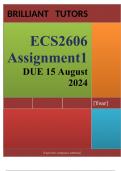BRILLIANT TUTORS
ECS2606
Assignment1
DUE 15 August
2024
[Year]
[Type the company address]
, Book
Environmental Economics
ECS2606 Assignment 1 (COMPLETE ANSWERS) Semester 2 2024 - DUE
15 August 2024 ; 100% TRUSTED Complete, trusted solutions and
explanations.
1. Discuss and diagrammatically illustrate the fundamental
balance principle. [10] Read the excerpt below and answer
the question that follows: Africa has made significant strides
in the growth of its solar energy industry in recent years, with
the continent seeing an increase of over 1.8W in new solar
installations, primarily led by Egypt, South Africa, Kenya,
Namibia, and Ghana. In order to simultaneously speed up
energy access and support sustainable economic growth,
Africa’s renewable energy mix has increasingly switched
away from conventional hydropower and thermal facilities to
renewable alternatives.
The Fundamental Balance Principle
Understanding the Principle
The fundamental balance principle in economics posits that for a market to be in equilibrium, the
quantity demanded of a good or service must equal the quantity supplied.
This balance occurs at the equilibrium price.
1. Law of Supply and Demand in Economics: How It Works - Investopedia
www.investopedia.com
2. Equilibrium Price: Definition, Types, Example, and How to Calculate - Investopedia
www.investopedia.com
, Diagrammatic Illustration
Demand curve: Represents the quantity of a good or service consumers are willing to
buy at different prices. It slopes downward, indicating that as price decreases, quantity
demanded increases.
1. Demand and Supply - Harper College
www2.harpercollege.edu
Supply curve: Represents the quantity of a good or service producers are willing to sell
at different prices. It slopes upward, indicating that as price increases, quantity supplied
increases.
1. Supply Curve Defined | NetSuite
www.netsuite.com
2. Supply Curve: Definition, How It Works, and Example - Investopedia




